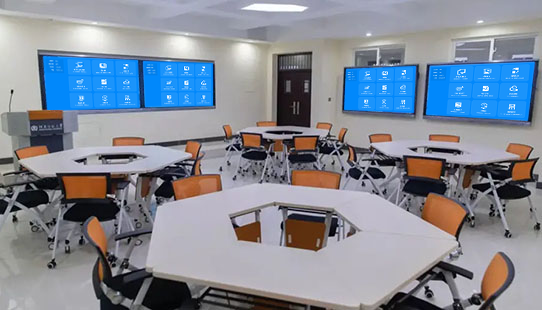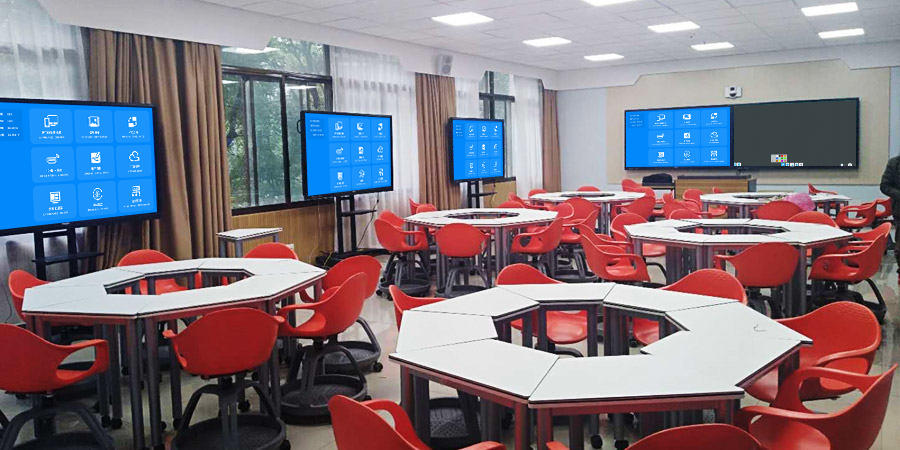Multi-Screen Interaction: A Collaborative Solution for Various Scenarios
Multi-screen interaction has been upgraded to an intelligent system of “device interconnection, data intercommunication, and scenario linkage.” It breaks down screen boundaries to build an efficient content ecosystem for education, office, display, and home scenarios.
Educational Scenarios: A New Model for Classroom Interaction
Core Value
Using a “main screen + group screens + personal terminals” architecture, it achieves a shift from “indoctrination” to “dialogue.”
- Layered Display: The main screen presents core content, while group screens handle differentiated tasks. The results can be projected onto the main screen for a one-click comparison.
- Real-Time Linkage: Experimental data generates a curve on the large screen, which students can annotate on their tablets, and the teacher’s terminal can provide synchronous guidance.
- Resource Penetration: Scanning an illustration in a textbook with a phone can project an educational video to a group screen, which can then be pushed to the main screen for sharing.
Hardware Solutions
- Standard Classroom: An 86-inch main screen + 6 55-inch group screens + student tablets are synchronized over a local area network.
- Innovation Lab: The main screen is linked with 4 touch-enabled experimental screens to record steps and provide synchronous warnings for abnormal data.
Office Scenarios: Accelerating Meeting Collaboration
Efficiency Breakthroughs
A network of a “main display screen + speaker screen + remote screen” boosts collaboration efficiency.
- Multi-Stream Concurrency: The main screen displays a proposal, while split screens on the sides show synchronized data, and a phone can be used to mirror supplementary information.
- Remote Penetration: A cloud linkage ensures that annotations on the main screen at the headquarters are synchronized in real time with those at branch offices.
- Dynamic Annotation: Scanning a QR code with a phone to annotate content on the main screen can generate a mind map of ideas on a side screen.
Device Deployment
- Small and Medium-Sized Conference Rooms: A 65-inch main screen + 2 auxiliary screens + a wireless module support interaction between local and remote devices.
- Lecture Hall: A dual-main-screen + audience partition screen setup allows the presenter to control switching with their phone, and questions are projected onto the main screen for answering.

Display Scenarios: Deep Penetration of the Marketing Experience
Conversion Path
A closed loop of “main screen for traffic attraction + interactive screen for experience + private domain screen for consolidation” promotes conversion.
- Scenario Penetration: The main screen plays a video, the interactive screen allows customers to select parameters, and a personalized guide is sent to their phones.
- Data Linkage: The main screen shows the product’s appearance, the interactive screen allows for configuration selection, and the private domain screen displays promotional offers.
- Social Amplification: An interactive solution can be projected to a sharing screen, where customers can save the details on their phones, extending the reach to online platforms.
Implementation Configuration
- Standard Store: A 65-inch main screen + 2 interactive screens + a private domain screen support parallel explanations and displays.
- Exhibition Booth: A folding main screen + 3 portable screens are linked via 4G to project solutions that match customer needs.
Home Scenarios: A New Dimension for Entertainment Experiences
Experience Expansion
A collaboration of “TV screen + tablet + phone” makes entertainment more engaging.
- Scenario Linkage: The TV plays an animation, a tablet is used for games, and a phone receives data. An excellent performance can be mirrored to the TV.
- Multi-Perspective Switching: The TV plays the main view of a sports game, a tablet shows data, and a phone displays a tactical analysis.
- Content Penetration: A video from a phone is mirrored to the TV, while a tablet simultaneously displays a map and notes.
Home Networking
- Basic Set: A smart TV + 2 tablets use Wi-Fi to achieve content flow and control.
- Immersive Set: A 4K TV + a projector + speakers are controlled by a phone for synchronization, creating a cinema-like experience.
Multi-screen interaction turns every screen into an information node. Through linkage and data penetration, it maximizes the value of each scenario.